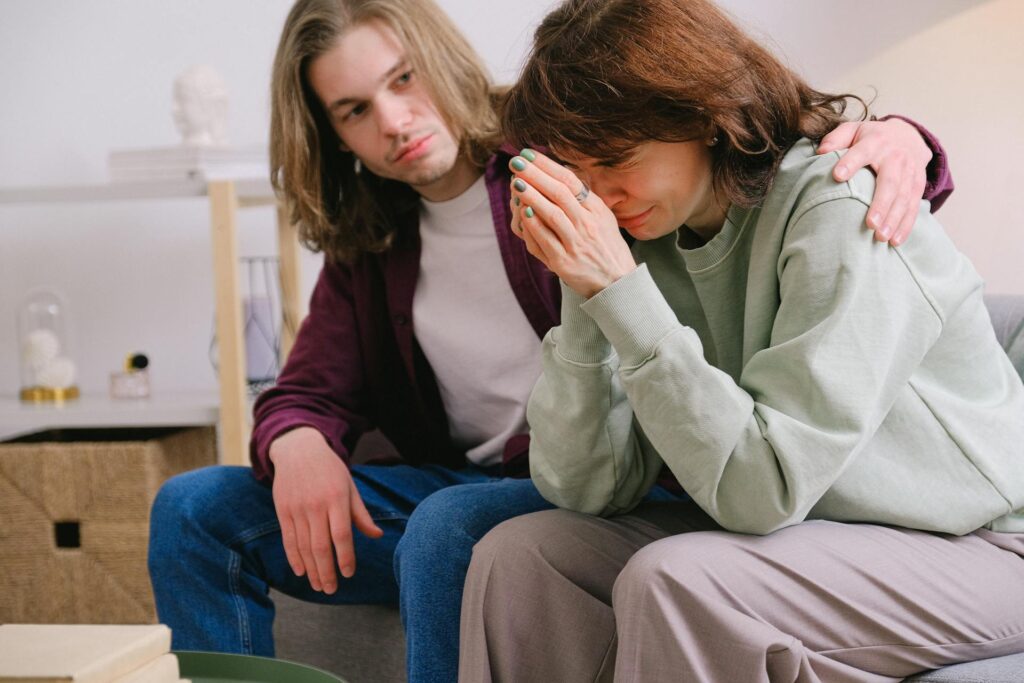Understanding Anxiety
Anxiety is a complex and multifaceted emotional response that serves as a natural alarm system, signaling potential threats or dangers.
It’s a feeling of unease, worry, or fear that can range from mild to severe, and it’s a normal part of the human experience. However, when anxiety becomes excessive, persistent, or interferes with daily functioning, it may indicate an underlying anxiety disorder.
At its core, anxiety involves a blend of physiological and psychological reactions. Physiologically, the body’s “fight or flight” response is activated, releasing hormones like adrenaline and cortisol. This results in physical symptoms such as increased heart rate, rapid breathing, muscle tension, and sweating. These responses are designed to prepare the body for immediate action.
Psychologically, anxiety manifests as intrusive thoughts, excessive worry, and a sense of dread. Individuals may experience difficulty concentrating, restlessness, and irritability. They might also engage in avoidance behaviors, attempting to steer clear of situations or triggers that provoke anxiety. Understanding the distinction between normal anxiety and an anxiety disorder is crucial. Normal anxiety is often situational and temporary, resolving once the stressful event passes. It’s proportionate to the situation and doesn’t significantly impair functioning.
Conversely, anxiety disorders involve persistent, excessive worry and fear that disrupt daily life. These disorders are characterized by chronic symptoms that interfere with work, relationships, and overall well-being. Factors contributing to anxiety include genetic predispositions, environmental stressors, and learned behaviors. Genetic factors can increase vulnerability, while traumatic experiences or stressful life events can trigger the onset of symptoms. Learned behaviors, such as avoidance, can perpetuate anxiety by reinforcing negative thought patterns.
Recognizing the triggers and patterns associated with anxiety is the first step towards effective management. Techniques like mindfulness, deep breathing exercises, and cognitive restructuring can help individuals regain control over their anxious thoughts and physical sensations. Seeking professional help is essential for a comprehensive evaluation and tailored treatment plan.
Connect Free. Improve your mental and physical health with a professional near you

Anxiety Disorders
Anxiety disorders are a category of mental health conditions characterized by persistent and excessive fear or worry that significantly impairs daily life. These disorders are distinct from normal anxiety, which is a temporary and situational response. Anxiety disorders involve chronic symptoms that interfere with work, relationships, and overall well-being.
Generalized Anxiety Disorder (GAD) involves persistent, excessive worry about various aspects of life, such as finances, health, or relationships. Individuals with GAD often experience restlessness, fatigue, and difficulty concentrating. Panic Disorder is marked by recurrent, unexpected panic attacks, which are intense episodes of fear accompanied by physical symptoms like rapid heartbeat, shortness of breath, and dizziness. Social Anxiety Disorder (SAD) involves intense fear of social situations, leading to avoidance of interactions or significant distress when social encounters are unavoidable.
Specific Phobias involve intense, irrational fear of specific objects or situations, such as spiders, heights, or flying. Obsessive-Compulsive Disorder (OCD) is characterized by intrusive, unwanted thoughts (obsessions) and repetitive behaviors (compulsions) performed to alleviate anxiety. Post-Traumatic Stress Disorder (PTSD) develops after exposure to a traumatic event and involves symptoms like flashbacks, nightmares, and hypervigilance.
The development of anxiety disorders is influenced by a combination of genetic, environmental, and psychological factors. Genetic predispositions can increase vulnerability, while stressful life events or traumatic experiences can trigger the onset of symptoms. Psychological factors, such as learned behaviors and negative thought patterns, also play a significant role.
Treatment for anxiety disorders typically involves a combination of therapy and medication. Cognitive Behavioral Therapy (CBT) helps individuals identify and change negative thought patterns and develop coping strategies. Medications, such as antidepressants and anti-anxiety drugs, can help alleviate symptoms. Early intervention and consistent treatment are crucial for managing anxiety disorders and improving quality of life.
Moreover, remote mental healthcare offers flexibility in scheduling. Individuals with demanding work schedules, childcare responsibilities, or other time constraints can more easily integrate therapy sessions into their lives. The ability to access therapy from the comfort of one’s home also creates a sense of safety and familiarity, fostering a more relaxed and open environment for therapeutic exploration.
Anxiety Symptoms
Anxiety symptoms manifest in a variety of ways, encompassing both physical and psychological experiences. Recognizing these symptoms is crucial for early detection and effective management. Physical symptoms often arise from the body’s “fight or flight” response, while psychological symptoms reflect the mental and emotional distress associated with anxiety.
Physical symptoms can include rapid heartbeat, palpitations, and chest tightness. Individuals may experience shortness of breath, hyperventilation, or a choking sensation. Muscle tension, trembling, or shaking are also common. Digestive issues, such as nausea, stomach cramps, or diarrhea, can occur. Sweating, dizziness, and lightheadedness are frequently reported. Sleep disturbances, including insomnia or restless sleep, are also prevalent.
Psychological symptoms of anxiety involve a range of emotional and cognitive experiences. Excessive worrying, often about future events or hypothetical situations, is a hallmark symptom. Individuals may experience intrusive thoughts or obsessions that are difficult to control. Restlessness and irritability are common, as is a sense of impending doom or dread. Difficulty concentrating and memory problems can interfere with daily tasks.
Fear and avoidance are significant psychological symptoms. Individuals may avoid situations or activities that trigger anxiety, leading to social isolation or limitations in their daily lives. Panic attacks, characterized by intense fear and physical symptoms, can be particularly distressing. Hypervigilance, or a heightened sense of awareness, can lead to constant scanning for potential threats.
The intensity and frequency of these symptoms can vary depending on the individual and the specific anxiety disorder. Recognizing the patterns and triggers associated with these symptoms is crucial for effective management. Techniques like deep breathing exercises, mindfulness meditation, and cognitive restructuring can help individuals cope with both physical and psychological symptoms. Seeking professional help is essential for a comprehensive assessment and tailored treatment plan. Early intervention can significantly improve outcomes and enhance quality of life.
Anxiety Types
Anxiety manifests in various forms, each with distinct characteristics and symptom profiles.
Understanding these different types is crucial for accurate diagnosis and effective treatment. While anxiety is a natural human emotion, anxiety disorders are characterized by persistent, excessive fear or worry that impairs daily functioning.
Generalized Anxiety Disorder (GAD) is characterized by chronic, excessive worry about various aspects of life, such as finances, health, or relationships. Individuals with GAD often experience restlessness, fatigue, and difficulty concentrating. Panic Disorder involves recurrent, unexpected panic attacks, which are intense episodes of fear accompanied by physical symptoms like rapid heartbeat, shortness of breath, and dizziness. These attacks can lead to significant anticipatory anxiety and avoidance behaviors.
Social Anxiety Disorder (SAD), also known as social phobia, involves intense fear of social situations, leading to avoidance of interactions or significant distress when social encounters are unavoidable. Individuals with SAD fear judgment, embarrassment, or humiliation in social settings. Specific Phobias involve intense, irrational fear of specific objects or situations, such as spiders, heights, or flying. These phobias can significantly limit an individual’s lifestyle.
Obsessive-Compulsive Disorder (OCD) is characterized by intrusive, unwanted thoughts (obsessions) and repetitive behaviors (compulsions) performed to alleviate anxiety. Obsessions cause significant distress, and compulsions are performed to neutralize that distress. Post-Traumatic Stress Disorder (PTSD) develops after exposure to a traumatic event and involves symptoms like flashbacks, nightmares, and hypervigilance. Individuals with PTSD often experience intense emotional distress and avoidance of trauma-related stimuli.
Separation Anxiety Disorder involves excessive fear or anxiety concerning separation from home or attachment figures. This disorder is more common in children but can also affect adults. Agoraphobia involves intense fear of places or situations that might cause panic, helplessness, or embarrassment. Individuals with agoraphobia often avoid public places or crowded areas.
Understanding the specific type of anxiety disorder is essential for tailoring treatment. Each type has unique triggers, symptoms, and treatment approaches. Proper diagnosis by a mental health professional is crucial for developing an effective management plan.
The growing body of evidence supporting the efficacy of remote mental healthcare has contributed to its increasing acceptance within the mental health community. This acceptance is further bolstered by the convenience, accessibility, and affordability of online therapy.
Anxiety Causes
Anxiety arises from a complex interplay of genetic, environmental, and psychological factors. While the precise causes are often multifaceted, understanding these contributing factors is crucial for prevention and treatment.
Genetic predispositions play a significant role in anxiety disorders. Individuals with a family history of anxiety disorders are more likely to develop these conditions themselves. Specific genes associated with neurotransmitter regulation and brain structure may increase vulnerability. Environmental stressors can trigger the onset or exacerbate existing anxiety. Traumatic experiences, such as abuse, neglect, or exposure to violence, can lead to PTSD or other anxiety disorders. Significant life changes, such as job loss, relationship problems, or financial difficulties, can also contribute to anxiety.
Psychological factors, such as learned behaviors and negative thought patterns, also play a crucial role. Learned behaviors, like avoidance, can perpetuate anxiety by reinforcing fear responses. Negative thought patterns, such as catastrophizing or overgeneralizing, can amplify anxiety symptoms. Personality traits, such as neuroticism or perfectionism, can increase vulnerability to anxiety disorders.
Brain chemistry and function also contribute to anxiety. Imbalances in neurotransmitters, such as serotonin, norepinephrine, and GABA, can affect mood and anxiety levels. The amygdala, a brain region involved in processing fear, may be overactive in individuals with anxiety disorders. Chronic stress can alter brain structure and function, leading to increased anxiety sensitivity.
Medical conditions, such as thyroid problems, heart disease, or chronic pain, can also contribute to anxiety symptoms. Certain medications and substance use can also induce or exacerbate anxiety. Identifying and addressing these underlying causes is essential for effective anxiety management. A comprehensive assessment by a mental health professional can help determine the specific factors contributing to an individual’s anxiety.
Anxiety Treatments
Effective anxiety treatments involve a combination of therapy, medication, and lifestyle adjustments. Tailored treatment plans are essential, as the most effective approach varies depending on the individual and the specific anxiety disorder.
Cognitive Behavioral Therapy (CBT) is a widely used and highly effective therapy for anxiety disorders. CBT helps individuals identify and change negative thought patterns and develop coping strategies. Exposure therapy, a component of CBT, involves gradually exposing individuals to feared situations or objects to reduce anxiety responses.
Medications, such as antidepressants and anti-anxiety drugs, can help alleviate anxiety symptoms. Selective serotonin reuptake inhibitors (SSRIs) and serotonin-norepinephrine reuptake inhibitors (SNRIs) are commonly prescribed antidepressants for anxiety disorders. Benzodiazepines are anti-anxiety medications that provide short-term relief but carry a risk of dependence.
Lifestyle adjustments play a crucial role in managing anxiety. Regular exercise, a balanced diet, and sufficient sleep can significantly reduce anxiety symptoms. Stress management techniques, such as mindfulness meditation, deep breathing exercises, and yoga, can help individuals cope with stress and anxiety.
Support groups can provide a sense of community and shared experience, helping individuals feel less isolated. Education about anxiety disorders is also essential for self-management and reducing stigma. Alternative therapies, such as acupuncture, massage, and herbal remedies, may provide additional support, but their effectiveness varies.
A comprehensive treatment plan often involves a combination of these approaches. Early intervention and consistent treatment are crucial for improving outcomes and enhancing quality of life. Regular follow-up with a mental health professional is essential for monitoring progress and adjusting treatment as needed.
Anxiety Therapy
Anxiety therapy encompasses various therapeutic approaches designed to help individuals manage and overcome anxiety disorders. These therapies aim to address the underlying psychological and behavioral patterns that contribute to anxiety, fostering healthier coping mechanisms and improved quality of life. Effective anxiety therapy typically involves a collaborative effort between the therapist and the individual, focusing on personalized strategies tailored to specific needs.
Cognitive Behavioral Therapy (CBT) is a cornerstone of anxiety therapy. It helps individuals identify and challenge negative thought patterns and irrational beliefs that fuel anxiety. CBT also incorporates exposure therapy, a technique that gradually exposes individuals to feared situations or objects, reducing their sensitivity over time. By modifying thought processes and behavioral responses, CBT empowers individuals to regain control over their anxiety.
Exposure therapy, often used within a CBT framework, is particularly effective for phobias and panic disorder. It involves systematic desensitization, where individuals are progressively exposed to anxiety-provoking stimuli in a controlled environment. This gradual exposure helps to extinguish the fear response and build resilience.
Acceptance and Commitment Therapy (ACT) is another valuable approach. ACT focuses on acceptance of anxious thoughts and feelings, rather than attempting to eliminate them. It encourages individuals to commit to valued actions and live a meaningful life, even in the presence of anxiety. ACT helps individuals develop psychological flexibility, allowing them to navigate anxiety without being controlled by it.
Dialectical Behavior Therapy (DBT) is particularly useful for individuals with intense emotional dysregulation and co-occurring conditions. DBT teaches skills such as mindfulness, emotional regulation, distress tolerance, and interpersonal effectiveness. These skills help individuals manage intense emotions and improve their ability to cope with stressors.
Psychodynamic therapy explores the underlying psychological conflicts and unresolved issues that may contribute to anxiety. By gaining insight into these unconscious processes, individuals can develop a deeper understanding of their anxiety and work towards resolution.
Choosing the right therapy depends on the individual’s specific needs and preferences. A qualified mental health professional can conduct a thorough assessment and recommend the most appropriate therapeutic approach. Consistent participation and active engagement in therapy are crucial for achieving lasting relief from anxiety.
Natural Anxiety Relief
Natural anxiety relief methods offer complementary approaches to traditional therapy and medication, focusing on lifestyle adjustments and holistic practices. These methods aim to reduce anxiety symptoms by promoting relaxation, stress reduction, and overall well-being. While these approaches may not replace professional treatment for severe anxiety disorders, they can be valuable tools for managing mild to moderate anxiety.
Regular exercise is a powerful natural anxiety reliever. Physical activity releases endorphins, which have mood-boosting effects. Exercise also reduces muscle tension and promotes better sleep, both of which are crucial for anxiety management. Aim for at least 30 minutes of moderate-intensity exercise most days of the week.
Mindfulness and meditation practices can significantly reduce anxiety symptoms. Mindfulness involves paying attention to the present moment without judgment, while meditation helps cultivate a calm and focused mind. These practices can reduce racing thoughts and promote relaxation. Deep breathing exercises can also quickly calm the nervous system during moments of heightened anxiety.
A balanced diet plays a crucial role in mental health. Consuming nutrient-rich foods, such as fruits, vegetables, whole grains, and lean proteins, can support brain function and reduce anxiety. Limiting caffeine and alcohol intake is also essential, as these substances can exacerbate anxiety symptoms.
Adequate sleep is vital for managing anxiety. Aim for 7-9 hours of quality sleep each night. Establishing a consistent sleep schedule and creating a relaxing bedtime routine can improve sleep quality.
Spending time in nature has been shown to reduce stress and anxiety. The calming effects of nature can promote relaxation and improve mood. Engaging in activities like hiking, gardening, or simply spending time in a park can be beneficial.
Herbal remedies, such as chamomile, lavender, and passionflower, may provide mild anxiety relief. However, it’s essential to consult with a healthcare professional before using herbal supplements, especially if you are taking other medications.
Social support is also a powerful natural anxiety reliever. Connecting with friends, family, or support groups can provide emotional support and reduce feelings of isolation. Implementing these natural strategies can complement professional treatment and promote long-term anxiety management.

Free consultations. Connect free with local health professionals near you.
Anxiety and the Brain
Anxiety and the brain are intricately connected. Understanding the neurological mechanisms underlying anxiety is crucial for developing effective treatment strategies. Anxiety involves a complex interplay of brain structures, neurotransmitters, and hormonal responses.
The amygdala, a brain region responsible for processing fear and emotional responses, plays a central role in anxiety. In individuals with anxiety disorders, the amygdala may be overactive, leading to heightened fear responses and increased sensitivity to perceived threats. This overactivity can trigger the “fight or flight” response, resulting in physical symptoms like rapid heartbeat and shortness of breath.
The prefrontal cortex, responsible for rational thinking and decision-making, helps regulate the amygdala. In individuals with anxiety, the prefrontal cortex may have difficulty overriding the amygdala’s fear responses, leading to persistent anxiety symptoms.
Neurotransmitters, such as serotonin, norepinephrine, and GABA, play a crucial role in mood regulation and anxiety. Serotonin helps regulate mood and sleep, while norepinephrine is involved in the “fight or flight” response. GABA has a calming effect on the brain. Imbalances in these neurotransmitters can contribute to anxiety disorders.
The hypothalamic-pituitary-adrenal (HPA) axis, the body’s stress response system, is also involved in anxiety. Chronic stress can lead to HPA axis dysregulation, resulting in prolonged cortisol release and increased anxiety sensitivity.
Brain imaging studies, such as functional magnetic resonance imaging (fMRI), have revealed structural and functional differences in the brains of individuals with anxiety disorders. These studies have shown altered activity in brain regions involved in fear processing, emotion regulation, and cognitive control.
Neuroplasticity, the brain’s ability to change and adapt, offers hope for anxiety treatment. Therapies like CBT can promote neuroplasticity by helping individuals develop new neural pathways and coping strategies. By changing thought patterns and behaviors, individuals can rewire their brains to reduce anxiety responses.
Understanding the neurobiological basis of anxiety underscores the importance of a comprehensive treatment approach. Combining therapy, medication, and lifestyle adjustments can address the complex interplay of brain mechanisms involved in anxiety, leading to improved outcomes and enhanced quality of life.
Anxiety Risk Factors
Anxiety disorders are influenced by a complex interplay of genetic, environmental, and psychological risk factors.
Understanding these factors is crucial for prevention, early intervention, and effective management. While not everyone exposed to these factors develops an anxiety disorder, they significantly increase vulnerability.
Genetic predispositions play a substantial role. Individuals with a family history of anxiety disorders are more likely to develop these conditions. Specific genes associated with neurotransmitter regulation and brain structure can increase susceptibility. This genetic vulnerability interacts with environmental and psychological factors, determining the likelihood of developing an anxiety disorder.
Environmental stressors are significant risk factors. Traumatic experiences, such as abuse, neglect, or exposure to violence, can lead to post-traumatic stress disorder (PTSD) or other anxiety disorders. Significant life changes, like job loss, financial difficulties, or relationship problems, can also trigger anxiety. Chronic stress from work, school, or daily life can contribute to sustained anxiety levels.
Psychological factors, including learned behaviors and negative thought patterns, play a crucial role. Learned behaviors, like avoidance, can perpetuate anxiety by reinforcing fear responses. Negative thought patterns, such as catastrophizing or overgeneralizing, amplify anxiety symptoms. Personality traits, such as neuroticism or perfectionism, increase vulnerability.
Brain chemistry and function are also implicated. Imbalances in neurotransmitters, such as serotonin, norepinephrine, and GABA, affect mood and anxiety levels. The amygdala, a brain region involved in fear processing, may be overactive in individuals with anxiety disorders, leading to heightened fear responses.
Medical conditions, such as thyroid problems, heart disease, or chronic pain, can contribute to anxiety symptoms. Certain medications and substance use, including caffeine, alcohol, and illicit drugs, can induce or exacerbate anxiety.
Social factors also play a role. Social isolation, lack of social support, and exposure to discrimination or prejudice can increase anxiety risk. Cultural factors can influence how anxiety is perceived and expressed, affecting help-seeking behaviors and access to treatment.
Identifying and addressing these risk factors is essential for prevention and early intervention. A comprehensive assessment by a mental health professional can help determine the specific factors contributing to an individual’s anxiety, leading to tailored treatment plans.
Panic Disorder
Panic disorder is an anxiety disorder characterized by recurrent, unexpected panic attacks, which are intense episodes of fear accompanied by significant physical symptoms. These attacks can be highly distressing and lead to significant anticipatory anxiety and avoidance behaviors.
Panic attacks involve a sudden surge of intense fear or discomfort that peaks within minutes. Physical symptoms can include rapid heartbeat, palpitations, chest pain, shortness of breath, dizziness, trembling, sweating, and nausea. Individuals may feel like they are losing control, having a heart attack, or dying.
The unexpected nature of panic attacks is a hallmark of panic disorder. Individuals may experience attacks without any apparent trigger, leading to fear and worry about future attacks. This anticipatory anxiety can significantly impair daily functioning and quality of life.
Agoraphobia, the fear of places or situations that might cause panic, helplessness, or embarrassment, often co-occurs with panic disorder. Individuals with agoraphobia may avoid public places, crowded areas, or situations where escape might be difficult.
The development of panic disorder is influenced by a combination of genetic, environmental, and psychological factors. Genetic predispositions can increase vulnerability, while stressful life events or traumatic experiences can trigger the onset of symptoms. Psychological factors, such as learned behaviors and negative thought patterns, also play a significant role.
Treatment for panic disorder typically involves a combination of therapy and medication. Cognitive Behavioral Therapy (CBT) is highly effective, helping individuals identify and change negative thought patterns and develop coping strategies. Exposure therapy, a component of CBT, involves gradually exposing individuals to panic-inducing situations to reduce fear responses.
Medications, such as antidepressants and anti-anxiety drugs, can help alleviate symptoms. Selective serotonin reuptake inhibitors (SSRIs) and serotonin-norepinephrine reuptake inhibitors (SNRIs) are commonly prescribed antidepressants for panic disorder. Benzodiazepines provide short-term relief but carry a risk of dependence.
Early intervention and consistent treatment are crucial for managing panic disorder and improving quality of life. Regular follow-up with a mental health professional is essential for monitoring progress and adjusting treatment as needed.
Childhood Anxiety
Childhood anxiety is a common issue affecting many children and adolescents. While some anxiety is a normal part of development, persistent and excessive anxiety can significantly impair a child’s social, emotional, and academic functioning. Early identification and intervention are crucial for preventing long-term problems.
Childhood anxiety disorders encompass several types, including generalized anxiety disorder (GAD), separation anxiety disorder, social anxiety disorder, and specific phobias. Separation anxiety disorder, characterized by excessive fear or anxiety concerning separation from home or attachment figures, is particularly common in younger children.
Symptoms of childhood anxiety can vary depending on the specific disorder and the child’s age. Common symptoms include excessive worry, restlessness, irritability, difficulty concentrating, sleep disturbances, and physical complaints like stomach aches or headaches. Children may also exhibit avoidance behaviors, such as refusing to attend school or social events.
Several factors contribute to childhood anxiety. Genetic predispositions can increase vulnerability, while environmental stressors, such as family conflict, school pressures, or traumatic experiences, can trigger anxiety. Learned behaviors and negative thought patterns, often influenced by parental anxiety, also play a significant role.
Early intervention is crucial for preventing childhood anxiety from developing into long-term problems. Treatment typically involves a combination of therapy and parental involvement. Cognitive Behavioral Therapy (CBT) is highly effective, helping children identify and change negative thought patterns and develop coping strategies.
Parental involvement is essential for successful treatment. Parents can learn strategies to support their child’s emotional needs and create a supportive environment. Family therapy can also be beneficial, addressing family dynamics that may contribute to the child’s anxiety.
School-based interventions can also play a vital role. Teachers and school counselors can provide support and accommodations to help children manage anxiety in the school setting. Creating a supportive and understanding environment is crucial for helping children overcome anxiety and thrive.
Conclusion
A comprehensive understanding of anxiety necessitates a multifaceted approach, acknowledging its inherent role as a natural human response while simultaneously recognizing the debilitating impact of anxiety disorders.
From exploring the fundamental nature of anxiety to dissecting its various types and causes, the journey underscores the intricate interplay of biological, psychological, and environmental factors. This exploration reveals that anxiety is not a monolithic entity but rather a spectrum of experiences, ranging from transient unease to chronic, disruptive conditions.
The detailed examination of anxiety symptoms highlights the diverse ways in which anxiety manifests, encompassing both physical and psychological dimensions. Recognizing these symptoms is pivotal for early detection and intervention, paving the way for effective management strategies. The articulation of anxiety treatments, spanning therapeutic interventions like Cognitive Behavioral Therapy (CBT) and Acceptance and Commitment Therapy (ACT), alongside pharmacological approaches, underscores the importance of tailored, evidence-based care. Moreover, the integration of natural anxiety relief methods, such as mindfulness, exercise, and dietary adjustments, emphasizes the holistic nature of anxiety management.
Delving into the neurobiological underpinnings of anxiety, particularly the roles of the amygdala, prefrontal cortex, and neurotransmitter systems, provides critical insights into the brain’s involvement in anxiety disorders. This knowledge facilitates a deeper understanding of the mechanisms driving anxiety and informs the development of targeted therapies. The consideration of anxiety risk factors, including genetic predispositions, environmental stressors, and psychological vulnerabilities, underscores the complex etiology of anxiety disorders, advocating for a preventative and proactive approach.
The specific focus on panic disorder and childhood anxiety highlights the diverse populations affected by anxiety and the unique challenges they face. Panic disorder, with its recurrent, intense episodes of fear, demands specialized treatment strategies. Childhood anxiety, often overlooked or misunderstood, necessitates early intervention to prevent long-term adverse effects.
Ultimately, addressing anxiety requires a collaborative effort involving individuals, healthcare professionals, and society as a whole. Destigmatizing mental health, promoting awareness, and ensuring access to comprehensive care are essential steps towards fostering a supportive environment for those struggling with anxiety. By integrating scientific understanding with compassionate care, we can empower individuals to navigate their anxiety, reclaim their well-being, and live fulfilling lives.
Time to feel better. Find a mental, physical health expert that works for you.
Common FAQs About Anxiety:
What's the difference between normal anxiety and an anxiety disorder?
Normal anxiety is a temporary response to stress, while an anxiety disorder involves persistent, excessive worry and fear that interferes with daily life.
What are the common symptoms of anxiety?
Common symptoms include rapid heartbeat, excessive worrying, restlessness, difficulty concentrating, muscle tension, and sleep disturbances.
What are the different types of anxiety disorders?
Common types include generalized anxiety disorder (GAD), panic disorder, social anxiety disorder (SAD), specific phobias, obsessive-compulsive disorder (OCD), and post-traumatic stress disorder (PTSD).
What causes anxiety disorders?
Anxiety disorders can be caused by a combination of genetic predispositions, environmental stressors, brain chemistry, and learned behaviors.
How is anxiety treated?
Treatment typically involves therapy (such as CBT), medication (like antidepressants or anti-anxiety drugs), and lifestyle adjustments (like exercise and stress management).
Can anxiety be cured?
While there may not be a complete “cure,” anxiety disorders can be effectively managed with appropriate treatment, allowing individuals to lead fulfilling lives.
Can natural remedies help with anxiety?
Yes, lifestyle changes like regular exercise, mindfulness, and a healthy diet can help manage mild anxiety. However, they shouldn’t replace professional treatment for severe anxiety disorders.
When should I seek professional help for anxiety?
If your anxiety is persistent, excessive, and interferes with your daily life, it’s time to seek professional help from a mental health professional.
Are panic attacks dangerous?
While panic attacks are very frightening and uncomfortable, they are not dangerous. The physical symptoms are the result of the body’s natural “fight or flight” response.
Can children experience anxiety disorders?
Yes, children can experience anxiety disorders. Early intervention is important.
How can I help someone with anxiety?
Offer support, listen without judgment, encourage them to seek professional help, and educate yourself about anxiety disorders.
Does anxiety get worse with age?
Not necessarily. Anxiety disorders can affect people of all ages. However, life stressors and health conditions associated with aging may contribute to increased anxiety in some individuals.
NOTICE TO USERS
MindBodyToday is not intended to be a substitute for professional advice, diagnosis, medical treatment, or therapy. Always seek the advice of your physician or qualified mental health provider with any questions you may have regarding any mental health symptom or medical condition. Never disregard professional psychological or medical advice nor delay in seeking professional advice or treatment because of something you have read on MindBodyToday.
Share this article

Let us know about your needs so we can answer any of your questions.

Fast and easy to understand quote

We come fully prepared.Hire when ready.
Popular Professionals Near You
You might also like
Emotional Intelligence
, What is Emotional Intelligence? Everything you need to know Find a Pro Emotional Intelligence: Origins The ascent of emotional […]
All About Emotional Contagion
, All About Emotional Contagion FIND LICENSE A PROFESSION Emotional Resonance in Relationships Emotional resonance, a profound and often subconscious […]
All About Emotional Abuse
, All About Emotional Abuse Find a license Pro Recognizing and Overcoming Emotional Abuse Emotional abuse, a silent epidemic, infiltrates […]





